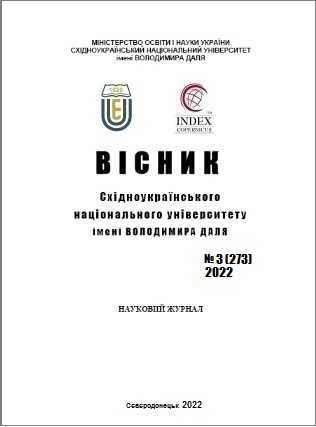Вибір ріжучого інструменту для обробки ливарної корки високолегованого вибіленого чавуна
DOI:
https://doi.org/10.33216/1998-7927-2022-273-3-30-38Ключові слова:
розширення технологічних можливостей, шліфувальний круг, різець, кубічний нітрит бору, вибілений високолегований чавун, режими різанняАнотація
У статті розглянуто проблеми механічної обробки деталей машин лезовими інструментами, виконаними з синтетичних надтвердих матеріалів, що мають унікальні фізико-механічні властивості. З широкої гами надтвердих матеріалів були обрані ті, що виробляються на основі кубічного нітриду бору (КНБ). В якості ріжучого інструменту були обрані токарні різці з механічним кріпленням пластин. Було надано перевагу круглим пластинам з гексаніту, який є однією з модифікацій полікристалічного кубічного нітриду бору, і має більш високу з усіх марок КНБ ударну стійкість. Розглянуто можливість застосування кубічного нітриду бору для виконання операції обдирки ливарної кірки зовнішніх поверхонь деталей «Валок листопрокатний», виконаних з високолегованого вибіленого чавуну хромонікелевого марки ЛПХНМдц-73 шляхом проведення ряду експериментальних досліджень. Визначено ресурс ріжучих пластин з кубічного нітриду бору модифікації гексаніту марки RNGN 190700 S02015. Були проведені порівняльні дослідження між стійкістю інструменту, працюючого у різних умовах – з різними твердістю поверхонь деталей та різними режимами різання. Визначено, що при обробці ливарної кірки зовнішніх поверхонь бочки високолегованих листопрокатних валків у всіх випадках ріжучі пластини, виконані з КНБ марки RNGN 190700 S02015 володіють значно більшим ресурсом у порівнянні з шліфувальними кругами з електрокорунду білого марки 25А 900×80×305 F3 6N 6V 50m/c. Результати експериментів показали, що стійкість пластин з КНБ на 80-82,7% більша ніж стійкість шліфувальних кругів. Ця значна різниця дозволила рекомендувати на операціях обдирки ливарної корки чавунних валків віддавати перевагу саме лезовій обробці на токарних верстатах. Крім того у статті доведено, що використання лезових методів обробки на операціях обдирки є більш економічно екологічно вигідним методом ніж шліфування. В статті також були запропоновані раціональні параметри режиму різання для забезпечення необхідної якості поверхневого шару деталей. Встановлено, що для виконання операції обдирки ливарної корки листопрокатних валків твердістю 81-83 НSD раціональними будуть режими: глибина різання t = 3…4 мм; подача S = 0,4 мм/об; швидкість різання V = 10…15 м/хв. Результати досліджень можуть бути використані для подальшого вибору раціональних умов механічної обробки заготовок з вибілених високолегованих чавунів підвищеної твердості у виробничій практиці.
Посилання
1. Робочі процеси високих технологій у машинобудуванні: підручник для студентів вищіх навчальних закладів / А.І. Грабченко та ін. Житомир: ЖДТУ, 2003. 415 с.
2. Инструменты из сверхтвердых материалов / под. ред.: Н.В. Новикова, С.А. Клименко. Изд. 2-е, перераб. и доп. М.: Машиностроение, 2014. 608 с.
3. Huang Y., Liang S.Y. Modeling of CBN Tool Flank Wear Progression in Finish Hard Turning // Trans. of the ASME: Journal of Manufacturing Science and Engineering, 2004, vol. 126, no. 1, pp. 98-107. DOI:https://doi.org/10.1115/1.1644543.
4. Грубый С.В., Лапшин В.В.Исследование режущих свойств резцов из нитрида бора: научное издание МГТУ им. Н.Э. Баумана. Наука и образование. 2012. №6. С. 61-76.DOI: http://dx.doi.org/10.7463/0612.0423622.
5. Макаров М.В. Повышение эффективности точения инструментом из СТМ на основе назначения рациональных режимов резания с учетом ультразвуковой диагностики его свойств: автореф. дис. … канд. тех. наук: 05.03.01. Рыбинск, 2000, 16 с.
8. http://www.weiss-diamant.com
10. Кроль О.С., Соколов В.І. Тривимірне моделювання металорізальних верстатів та інструментального оснащення. Сєвєродонецьк: СНУ ім. В. Даля, 2016. 160 с.
11. Krol O., Sokolov V., Tsankov P. Modeling of vertical spindle head for machining center. Journal of Physics: Conference Series. 2020, No. 1553. 012012. – VSPID-2019. http://doi.org/10.1088/1742-6596/1553/1/012012
12. Krol O.S., Osipov V.I. Modeling of construction spindle’s node machining centre SVM1F4/Comission of Motorization and Power Industry of Agriculture. – OL PAN, 2013, Vol.13, is.3, Lublin, Poland. – P. 108–113
13. Krol O., Juravlev V. Modeling of spindle for turret of the specialized tool type SF16MF3// TEKACom. Mot. andEnerg. in Agriculture. – OLPAN, 2013, Vol.13, No 4,Lublin, Poland. Р. 141–147.
14. Krol O., Sukhorutchenko I. 3D-modeling and optimization spindle’s node machining centre SVM1F4 // TEKA Commision of Motorization and Energetic in Agriculture. –Vol.13. – № 3. 2013. – Lublin, Poland. P. 114–119.
15. Гартфельдер В.А., Секлетина Л.С., Янюшкин А.Р.Лезвийная обработка закаленных сталей инструментами из кубического нитрида бора // Системы. Методы. Технологии. 2020.№1(45). С. 29-33. DOI: http://dx.doi.org/10.18324/2077-5415-2020-1-29-33
16. Куликов М.Ю. Картамышев А.Ю. Влияние структуры на работоспособность инструмента из нитрида бора при чистовой обработке деталей, упрочненных методами электроконтактных технологий // Вестник Ивановского государственного энергетического университета. 2011. Вып. 1. С. 62-64.
17. Куц В.А.Совершенствование процесса механической обработки чугунных прокатных валков с целью повышения производительности и улучшения эксплуатационных свойств: дис. … канд. тех. наук: 05.03.01. Екатеринбург, 1999. 203 с.
18. Шумакова Т.А. Повышения производительности механической обработки деталей из отбеленных высоколегированных чугунов // Вісник національного технічного університету «ХПІ». Збірник наукових праць. Серія: Механіко-технологічні системи та комплекси. 2015р. №11(1120). С.108-115.
19. Коган Б И. Прогрессивные режущие материалы для токарной обработки восстанавливаемых поверхностей деталей машин // Вестник Кузбасского государственного технического университета. 2013. № 1. С. 58-64.
20. Тотай А.В., Нагоркин М.Н., Федоров В.П. Детали машин. Современные средства и прогрессивные методы обработки: учебник для академического бакалавриата Изд. 2-е, перераб. и доп.: Москва – Юрайт, 2016. 288 с.
21. Жижкина Н.А. Научные и технологические основы литья крупногабаритных биметаллических заготовок для прокатных станов: дис. … док. тех. наук: 05.16.04. Брянск, 2017. 421 с.
22. Гальчук Т.Н. Вдосконалена технологічна схема переробки шламових відходів машинобудування // Вісник Хмельницького національного університету. 2012. №4 С. 26-30.
23. Криворучко Д.В.,Некрасов С.С.,Нешта А.А. и др. Выбор инструментальногоматериаларежущих пластин для обработки износостойкого чугуна // Збірник наукових праць: Процеси механічної обробки в машинобудуванні. 2013. Вип. 14. С 82-94.

